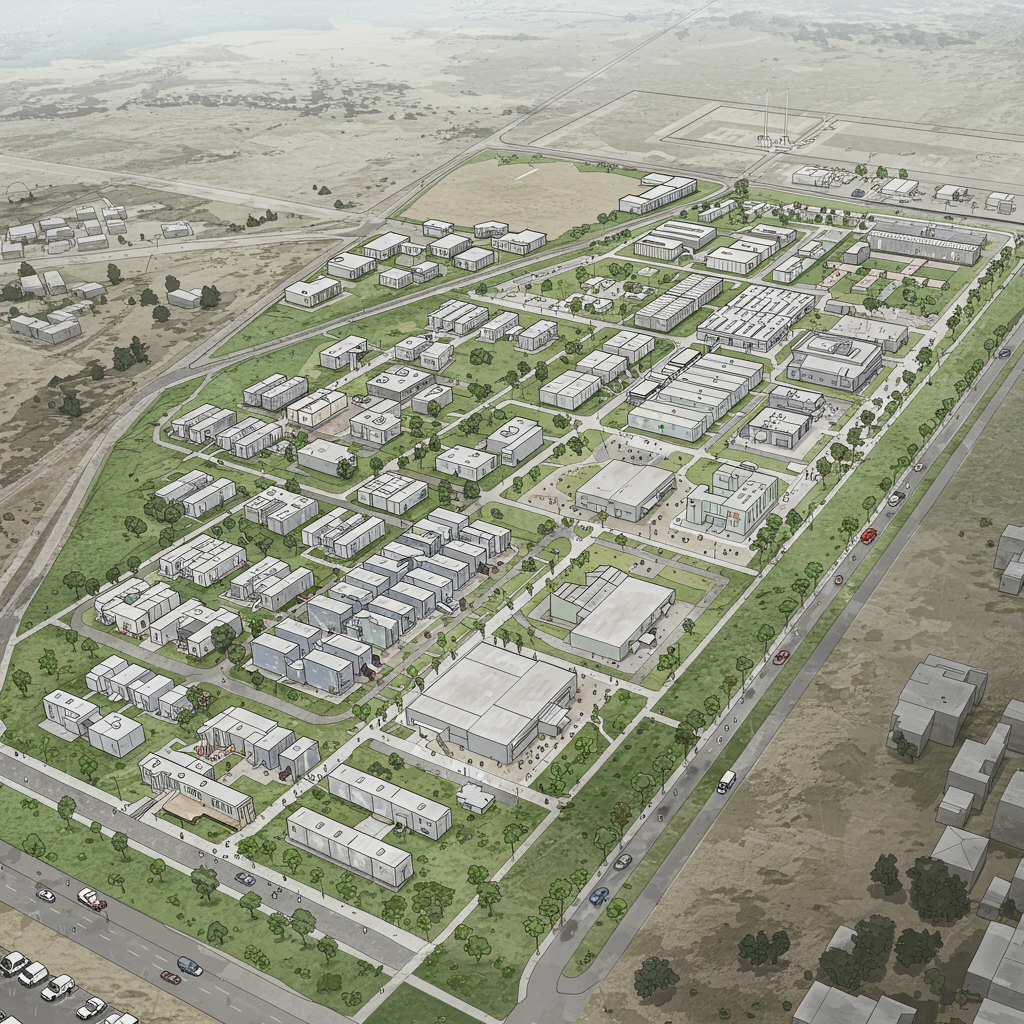An exclusive proposal has emerged, detailing a controversial concept for establishing large-scale facilities for Palestinians displaced in Gaza. These planned sites, termed “humanitarian Transit Areas,” or HTAs, are outlined in a document bearing the name of the U.S.-backed Gaza Humanitarian Foundation (GHF). The proposal, which envisions a significant $2 billion investment, describes a vision aimed at drastically altering the population control structure within the territory, specifically “replacing Hamas’ control over the population in Gaza.”
A Vision for ‘Humanitarian Transit Areas’
The core idea behind the proposal is to create designated areas where Gazan Palestinians could be housed. These locations are intended for temporary stays, offering space for residents to “temporarily reside, deradicalize, re-integrate and prepare to relocate if they wish to do so.” The plan paints a picture of structured environments facilitating profound changes for the population amidst the ongoing crisis.
The Proposed Scope and Purpose
The concept is described as “large-scale” and intended for significant numbers of people. While framed as “voluntary,” the context of persistent bombardment and severe aid restrictions raises serious questions about genuine choice. The overarching goal extends beyond simple shelter, incorporating elements of behavioral change and preparation for potential movement away from Gaza.
Connections to the Trump Administration
The document reviewed by Reuters reportedly originated sometime after February 11 and was submitted to the Trump administration. According to sources familiar with the matter, the proposal was recently discussed within the White House. This connection aligns with former President Donald Trump’s prior public statements from February 4, where he suggested the U.S. could “take over” Gaza, rebuild it, and resettle its population elsewhere. Such comments had already fueled anxieties among Palestinians and humanitarian groups regarding potential forced relocation.
Plan Details and Logistics
A comprehensive slide deck provides granular details regarding the proposed “Humanitarian Transit Zones.” It covers implementation strategies and projected costs. The plan suggests leveraging these sprawling facilities not only for housing but also to cultivate trust with local residents. It explicitly links the initiative to supporting U.S. President Donald Trump’s “vision for Gaza.”
Scale, Timeline, and Activities
The proposal sought over $2 billion in funding for the project. Initial planning documents envisioned a camp becoming operational within 90 days of the project’s launch. This first phase would accommodate 2,160 people, providing essential services like laundry, restrooms, showers, and even a school. A source involved in the planning indicated the long-term vision encompasses a total of eight camps. Each of these facilities would be capable of sheltering hundreds of thousands of Palestinians. The proposal outlines a role for the linked organization to “oversee and regulate all civil activities required for construction, deradicalization and temporary voluntary relocation.”
Potential Locations
The plan suggests locations both inside and potentially outside the Gaza Strip. While specific external sites were not finalized, a map included in the proposal displayed arrows pointing towards Egypt and Cyprus. Other areas were simply labeled as “Additional Destination?”. This raises further questions about the long-term intentions and feasibility of moving large numbers of people across international borders.
Uncertainty and Denials
Despite the detailed nature of the document, Reuters was unable to independently verify its exact status. It remains unclear precisely who created or formally submitted the proposal. Furthermore, whether the plan is still actively under consideration could not be definitively determined.
GHF and SRS Responses
The Gaza Humanitarian Foundation, whose name appears on the proposal’s cover, denied submitting such a document when questioned by Reuters. GHF stated that the slides were “not a GHF document.” The organization acknowledged studying “a range of theoretical options to safely deliver aid in Gaza.” However, it asserted that it “is not planning for or implementing Humanitarian Transit Areas (HTAs).” GHF maintained its sole focus is currently on food distribution within Gaza. SRS, a for-profit contracting firm working with GHF and mentioned on several slides, also denied discussing HTAs with GHF. A spokesperson claimed their priority was solely “feeding more people.”
Significant Humanitarian Concerns
The concept of moving large segments of Gaza’s population into camps, even if labeled “voluntary,” has generated considerable alarm among humanitarian experts. They highlight the inherent coercion faced by a population enduring prolonged conflict and aid blockades.
Expert Perspectives
Jeremy Konyndyk, president of Refugees International and a former senior U.S. aid official, reviewed the plan and described it as alarming. He emphasized that “voluntary displacement” is not a realistic concept for people under constant bombardment and cut off from essential supplies for nearly two years. Such a proposal risks deepening existing fears about forced relocation. A source involved in the project reportedly claimed the intent was to provide a “safe area” for families to escape Hamas control and alleviate fear.
Criticisms from Hamas and the UN
Hamas, the group controlling Gaza, categorically rejected the organization linked to the proposal. Ismail Al-Thawabta, director of the Hamas-run Gaza government media office, labeled the GHF “not a relief organization.” He described it instead as “an intelligence and security tool affiliated with the Israeli occupation,” operating under a false humanitarian facade. The United Nations has also voiced strong criticism regarding GHF’s existing aid operations. The UN has called GHF’s approach “inherently unsafe” and a violation of humanitarian impartiality rules. The UN human rights office has documented significant casualties, recording at least 613 killings at GHF aid points and near convoys operated by other relief groups, including the UN itself.
Current Status and Funding Challenges
The exact current status of the ‘Humanitarian Transit Areas’ proposal remains uncertain. While a source suggested it had not moved forward due to a lack of funds, official statements conflict.
Conflicting Accounts
A senior administration official denied that “nothing of the like is under consideration.” The official also stated that “no resources are being directed to that end in any way.” This contrasts with the source involved in planning who cited funding as the obstacle. Reuters previously reported that GHF encountered difficulties securing banking partnerships, with UBS and Goldman Sachs reportedly declining to work with the organization. However, the U.S. State Department approved $30 million in funding for GHF in June, urging other countries to support the group’s general activities.
Context of Crisis
The proposal surfaces amidst a severe humanitarian crisis in Gaza. Triggered by the October 7, 2023, Hamas attack and Israel’s subsequent military campaign, the conflict has resulted in immense loss of life and displacement. Gaza’s health ministry reports over 57,000 Palestinians killed, a widespread hunger crisis, and the internal displacement of nearly the entire population of 2.3 million. This backdrop intensifies concerns surrounding proposals that involve moving or resettling the population.
Frequently Asked Questions
What is the ‘Humanitarian Transit Areas’ proposal for Gaza?
The ‘Humanitarian Transit Areas’ proposal outlines a plan to build large-scale camps inside, and potentially outside, the Gaza Strip. These facilities are intended to temporarily house displaced Palestinians. The plan suggests the areas would facilitate temporary residence, “deradicalization,” “re-integration,” and preparation for potential “voluntary relocation,” aiming to replace Hamas’s control over the population.
Which group is linked to the Gaza ‘Humanitarian Transit Areas’ proposal?
The proposal document seen by Reuters bears the name of the Gaza Humanitarian Foundation (GHF), a U.S.-backed aid group. However, both GHF and a contracting company working with them, SRS, have denied submitting the proposal or that the slides are official documents. While GHF is favored by the Trump administration and Israel for aid distribution, the UN has criticized their current operations as unsafe and biased.
Why are humanitarian experts concerned about the Gaza camp proposal?
Humanitarian experts express alarm because the plan involves potentially moving a large population under duress, questioning the “voluntary” nature of displacement for people under constant bombardment and facing aid restrictions. Groups like Refugees International argue true voluntary relocation is impossible in this context. Critics also point to the controversial nature of the group linked to the proposal and broader concerns about the safety and impartiality of their operations.
Conclusion
The emergence of the ‘Humanitarian Transit Areas’ proposal reveals a significant and controversial concept for managing the displaced Palestinian population in Gaza. While linked to a U.S.-backed aid group and reportedly discussed within the Trump administration, the plan’s exact status and authorship remain unclear, with denials from the named organization. The proposal, with its $2 billion scope and detailed vision including deradicalization and potential relocation outside Gaza, raises profound humanitarian concerns about forced displacement and the ethics of such large-scale population management in a conflict zone. The conflicting reports on its current consideration and funding underscore the uncertainty surrounding this contentious plan amidst the ongoing crisis.



